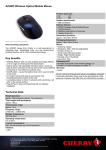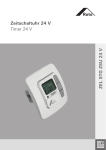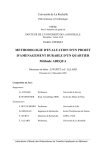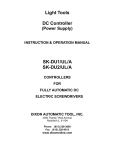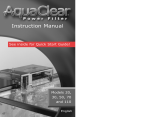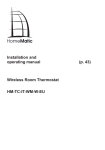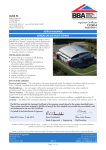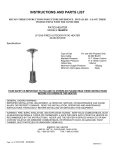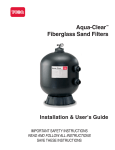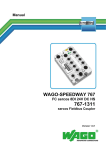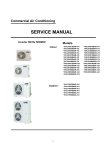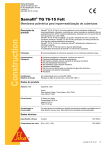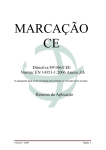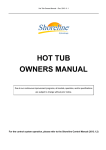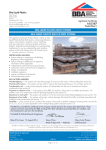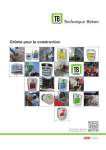Download User manual A Z U R 0
Transcript
AZU R0 User manual 614545-04 Important safety instructions For the safety of individuals, it is important these instructions are followed. The instructions are to be kept in a safe place. Only appropriately qualified personnel are allowed to undertake maintenance and repair work. Maintenance should be undertaken at least once per year. Prior to any maintenance or repair work, the window is to be disconnected from the mains and the drive is to be decoupled. In extreme weather conditions due to snow, frost and temperatures from -3° C, the window is not to be opened This device is not intended to be used by people (including children) with limited physical, sensory or mental abilities or who lack experience and/ or knowledge, unless they are supervised by a person responsible for safety or have been instructed on how the appliance is to be used. Children should be supervised to ensure that they do not play with the appliance. 2 Do not place objects in the operating range of the window. Fixed objects in the area of the infrared safety sensors will be “taughtin” by the sensors after 5 minutes, i.e. accepted as background. Do not lean out of the window or climb through the window. Do not use window frame as climbing aid or step. The two infrared safety sensors are used to avoid injuries due to trapping or crushing by the motorised window sash at the two main closing edges (left and right). Reducing the effectiveness of the infrared safety sensors (e.g. covering with tape, wallpaper) is forbidden. Also cleaning the infrared safety sensors using caustic cleaning agents, which could “blind” the sensors, is to be avoided. 3 On moving the window sash manually (with motor decoupled), attention is to be paid to ensuring the hands or fingers are not crushed at the closing edges or at the stack storage box. Please pay attention to adequate ventilation to prevent the formation of condensation! 4 Commissioning the Azuro Prior to placing in operation the Azuro, the window is to be placed in the cleaning position (page 9-10) and thoroughly cleaned (page 15-20) Once the window is placed in operation electrically, i.e. the controller for the window is supplied with power (230VAC), the infrared sensors take a reference measurement. This measurement takes approx. 12 sec. and is indicated by a flashing red light emitting diode. Electrical (E) During the reference measurement, there must not be any person or object in the detection area (distance approx. 2m from the window), as otherwise the measurement will be prevented! If the foil collar of the window is not yet bonded to the moisture barrier following installation, it may be moved by a gust of wind and it may be detected as an obstacle by the sensor. Then the window stops. Operating the window The sliding window is equipped with an electric motor drive. To open or close the sliding window, press the button. To stop the window movement between the end positions, it is necessary to press the same button again. 5 Electrical radio (EF) Teaching the master remote control: Switch the receiver to learn mode. Switch the Azuro controller power supply off, and after 5 seconds switch it back on. The Azuro controller is now in learn mode for 3 minutes Teaching the master remote control: Note: Refer to the operating instructions for the remote control. Within the learn mode period, press the teach button of the master remote control for about 10 seconds. This completes the teaching process. 6 Rain sensor The window is equipped with a rain sensor. If the sensor detects rain, the window closes automatically and indicates this operation on the red light emitting diode. If the rain sensor is activated, it is not possible to open the window. Safety functions The main closing edges of the window are monitored by infrared sensors. In this way it is prevented that people or objects in the danger zone are trapped or crushed during the window movement. Approx. 80 cm in the middle of the window are not monitored! If people are detected approaching the moving window, the movement of the window is interrupted immediately. The detection of a person or an object is also indicated by a red light emitting diode on the infrared sensor. With the cover on the stack storage box open, a safety switch locks the window drive-unit so that no window movement can take place. 7 Explanation of symbols The light emitting diode indication Rain sensor is detecting rain, window is closing automatically, opening is not possible. Level sensor is detecting liquid in the storage box, drainage pump is activated. Drive decoupled, window can be moved by hand, in conjunction with sash separating position, cleaning position is possible. Sash separating position, in conjunction with de-coupled drive cleaning position is possible. 8 Cleaning position To be able to clean all window sashes from the outside, it is necessary to separate the linked sashes. Right side stack storage box, activation of manual operation counter clockwise. 1 For this purpose the window is moved into the stack storage box until only half of the middle sash is still visible. 2 Motor operation Manual operation Left side stack storage box, activation of manual mode clockwise. Next the drive must be decoupled. For this purpose an allen key is inserted in the hole in the window frame and turned approx. 220° (right) counter clockwise or (left) clockwise to the stop. The complete decoupling of the drive is indicated by the illumination of the yellow lighting emitting diode on the sensor on the left. Now the window can be moved by hand to the separating position (approx. 1/3 of the 2nd sash visible). This position is indicated by a further yellow light emitting diode. 1 2 Motor operation Manual operation Separating position: Approx. 1/3 of the 2nd sash visible 9 By operating a hidden switch in the stack storage box (approx. 3cm below the hole), the sash remaining in the stack storage box is separated by the motor. (Only functions if both yellow light emitting diodes are illuminated!) This process takes approx. 1 minute and a slight motor noise can be heard. It is to be noted that the position of the sash must not be changed during this process. It is imperative you wait until the motor movement has finished! Once the sash separation is complete, the two remaining sashes can be moved to the middle where they can be cleaned on both sides. The sash in the stack storage box can be cleaned through the gap using a pole. 10 Joining sashes back together Push the two window sashes to the separating position (approx. 1/3 of the 2nd sash visible). You can see this position has been reached on the yellow light emitting diode on the right. Separating position: Approx. 1/3 of the 2nd sash visible Do not push sash further into the stack storage box. Return the hidden switch to its original position. The sash in the stack storage box is raised by the motor. This process takes approx. 1 minute and a slight motor noise can be heard. Right side stack storage box, activation of motor drive clockwise. 2 1 It is imperative you wait until the motor movement is finished! Motor operation Manual operation Left side stack storage box, activation of motor drive counter clockwise. Re-couple the drive by turning the allen key on the opposite direction (see page 9). The window is now ready for normal operation again. 1 2 Manual operation Motor operation 11 Indications of malfunctions: Drive shutdown due to overload To protect the drive motor against overload, e.g. due to jamming, the motor current is monitored. If this current exceeds a certain value, the motor is shut down and an acoustic fault signal is output with the sequence shown. At the same time the “Level” light emitting diode flashes at the same rate. To switch off the alarm it is necessary to press any button on the OPEN/ CLOSE switch for at least 2 seconds. Fault rectification: A possible cause may be a foreign body in the roller track. Remove item jamming the window. If the Azuro still does not close, set window to manual operation (see page 9). Unlocking stiff. Push sash back into the stack storage box and try to close again by hand. Please contact customer service! 12 1s 1s 3s ... = Peeping signal tone Infrared safety sensors not working Prior to each OPENING or CLOSING movement of the window, a test signal is output to the safety sensors. If this signal is not returned correctly by the sensors, safe operation of the window cannot be ensured. In this case an acoustic fault signal is output with the sequence shown. 4s 2s ... = Peeping signal tone At the same time, both light emitting diodes, “Rain” and “Level” flash at this rate. If this fault occurs, it is only possible to close the window, this means you must keep the CLOSE button pressed until the window is closed. An OPEN movement is no longer possible. To switch off the acoustic alarm it is necessary to press any button on the OPEN/CLOSE switch for at least 2 seconds. Fault rectification: A possible cause could be the reference image (see page 3). This image may have been lost. Disconnect Azuro from the mains for approx. 10 seconds, then undertake a test run again. Now the reference measurement is made again, during this time please keep away from the area of the window. Another cause could also be a faulty sensor. Please contact customer service! 13 Water drainage does not work The window is equipped with a liquid sensor and drainage pump to remove water (condensed water, snow, etc.) that could accumulate in the stack storage box. The pump only operates at a temperature from +5° C. If the liquid sensor is faulty, or the pump does not manage to drain the stack storage box after several attempts, an acoustic fault signal is output with the sequence shown. At the same time the “Level” light emitting diode flashes at this rate. To switch off the acoustic alarm it is necessary to press any button on the OPEN/CLOSE switch for at least 2 seconds Fault rectification: A possible cause could be the hose for the pump, it may have become detached or blocked. A dirty filter could also be a possible cause. Please contact customer service! 14 2s 2s 2s ... = Peeping signal tone Maintenance It is recommenced to have the Azuro cleaned and maintained at least once a year by a tradesman. During this process, it is imperative the safety instructions given (page 2-4) are followed. Open cover on the stack storage box and fix using safety hook. Guide safety chain through feature on the end of the chain to prevent possible detachment of the hook. With the cover open the drive motor is deactivated and can therefore not be placed in operation.. On closing the cover, attention is to be paid to ensuring the safety hook is in the holder (inside cover) to prevent jamming of the sash. 15 The back of the Azuro stack storage box is fitted with a highly efficient vacuum insulation. Never drill or screw deeper than 25mm! Changing rubber buffers The rubber buffers for the hex screws must be changed once a year. Cleaning seals and surfaces On completion and subsequent usage of the window, attention is to be paid to removing the dust from construction from the surface of the seal on the frame and between the sashes. The seals are treated once a year with a Roto cleaning and care set. 16 Vacuum insulation Polystyrene Max. 25mm Maintenance of grey sliding coating The grey sliding coating in the stack storage box are to be freed of chips and other dirt prior to placing in operation. If the truss has settled, the window may not run as well as before. Here attention is to be paid to ensuring the bottom of the sash is flush with the grey sliding coating. Should this not be the case, the preset grey sliding coating can be readjusted. The grey strips are to be cleaned once a year using a cloth free of chemicals. It is recommended to replace the grey strips after approx. 5 years. Maintenance of pump To free the stack storage box of water droplets and condensed water, a drainage pump is installed. This pump removes the liquid that has collected on the base of the stack storage box. A filter protects the pump against larger particles of dirt. The filter is to be cleaned of dirt during the maintenance. 17 Cleaning roller track Foreign bodies on the roller track (top and bottom) can cause the Azuro to no longer close. The individual sashes can also be damaged. Cleaning sash flashing Free bottom sash flashing of dirt once a year and remove film of dirt. Maintenance of drive chain The drive chain must be regreased at least once a year, with for instance Chesterton type 622. 18 Maintenance of chain The top and bottom chain in the stack storage box must be maintained at least 1x year using penetrating oil. Only then is smooth function guaranteed Maintenance and cleaning of sashes After placing in the cleaning position (see page 9-10), the sashes can be cleaned using standard silicone-free glass cleaner, a sponge and squeegee. 19 Care The initial activation of Aquaclear is dependent on the orientation of the roof relative to direct exposure to sunlight and the time of year. Following installation, please wait a few weeks before cleaning the pane with plenty of water for the first time. Later it will seldom be necessary to clean the special glazing. Use a solution of gentle, non-abra- 20 sive cleaning agent and water. Never use products containing silicone. The same applies to chemical products and those intended for the care of materials other than glass. Only use alcohol or ammonia-based cleaners selectively. After cleaning, rinse the pane and wipe it dry with a soft, non-fluffy cloth. If the window is cleaned by a professional cleaning firm, be sure to familiarise the personnel with the information on care of the special coating. Maintenance and cleaning of rain sensor To be able to ensure correct function, the rain sensor must be freed of dirt (pollen, leaves, bird droppings etc.). If the sensor surface becomes dirty, please only clean it with soapy water and rinse well. Azuro separate from the power requirement bevore cleaning the rain sensor. 21 What to do if? Fault Window does not open on pressing button Cause -Person or object in the field of the view of the safety sensors -Rain sensor is detecting moisture -Rain sensor dirty -Window is decoupled -Cover of stack storage box not closed 22 Rectification -Remove person or object from this area -Wait until the rain sensor is dry -Clean rain sensor -Couple window -Close cover, pay attention to safety switch! Window closes automatically -Rain sensor is detecting moisture -Rain sensor dirty -Wait until the rain sensor is dry -Clean rain sensor Window does not close on pressing button -Person or object in the field of view of the safety sensors (e.g. also due to plants moved by the wind) -Window is decoupled -Cover of stack storage box not closed -Remove person or object from this area -Couple window -Close cover, pay attention to safety switch! Cleaning position: Sashes do not separate, no motor noise -Drive not decoupled -Window sash not in separating position -Decouple drive -Slide sash to the separating position Cleaning position: Sashes cannot be joined back together, no motor noise -Drive not decoupled -Window sash not in separating position -Decouple drive -Slide sash to the separating position Namep AZU RO8 AZU WD HDW 26/17xVA xxxxx Hxx AZU R0. R08 WD HBW 26/17xVA xxxxx HA N www.roto-frank.com www.roto-frank.com AZU RO8 nk ente GmbH :2006 ws for n applications AZU RO9V Roto Frank Bauelemente GmbH Roto Frank Bauelemente GmbH EN 14351-1:2006 EN 14351-1:2006 Roof windows for construction applications Roof windows for construction applications o wind load Grade C3/B3 o snow Resistance to wind load nt load 4/16/6 performance D,s2-d0/Broof(t1) Resistance to snow ss E 1200 and permanent load ance Grade 5 External fire performance capacity ices npd Watertightness formance 37 (-1,-4) dB Impact resistance smission coefficient (Uw) Load-bearing mory stack 1.4 W/(m²K) capacity smission coefficient (Um)of safety devices mory stack 1.1 W/(m²K) Acoustic performance transmission rate (g) 44 Thermal transmission coefficient ttance rate (tv) 71 lity Grade 3memory stack without nk.com AZU R0. WD HBW 26/17xVA xx www.roto-frank.com Nameplate (Uw) Thermal transmission coefficient (Um) including memory stack Total energy transmission rate (g) Light transmittance rate (tv) Air permeability Restistance to wind load Resistance to snow Class and Grade C3/B3 permanent load External fire performance Watertightness 4/16/6 Impact resistance D,s2-d0/Broof(t1) Load-bearing capacity E 1200of safety devices Acoustic performance Class 5 Grade Thermal transmission coefficient (Uw) without memory stack npd Thermal transmission coefficient (Um) including memory stack 37 (-1,-4) dB Total energy transmission rate (g) Light transmittance rate (tv) Air permeability 1.4 W/(m²K) 1.1 W/(m²K) www.roto-frank.com 44 48 71 68 Grade Class 3 www.roto-frank.com 23 Grade C3 4/10/4/10 D,s2-d0/ E 1200 Grade 5 npd 38 (-2,-4 1.0 W/(m 0,81 W/( 38 51 Grade 3 meplate xV A x x x x x H A N Nameplate AZU RO9V AZU R09 WD HDW 26/17xVA xxxxx Hxx AZU R0. WD HBW 26/17xVA xxxxx HA N www.roto-frank.com www.roto-frank.com AZU RO8 rank emente GmbH 1-1:2006 AZU RO9V Roto Frank Bauelemente GmbH EN 14351-1:2006 ndows for tion applications e to wind load e to snow anent load fire performance tness sistance ring capacity devices performance ransmission coefficient (Uw) memory stack ransmission coefficient (Um) memory stack gy transmission rate (g) smittance rate (tv) ability frank.com Roof windows for construction applications Grade C3/B3 Restistance to wind load 4/16/6 D,s2-d0/Broof(t1) Resistance to snow E 1200 and permanent load Grade 5 External fire performance npd Watertightness 37 (-1,-4) dB Impact resistance Load-bearing capacity 1.4 W/(m²K) of safety devices 1.1 W/(m²K) Acoustic performance 44 Thermal transmission coefficient (Uw) 71 Grade 3 memory stack without Thermal transmission coefficient (Um) including memory stack Total energy transmission rate (g) Light transmittance rate (tv) Air permeability www.roto-frank.com 24 Roto Frank Bauelemente GmbH EN 14351-1:2006 Roof windows for construction applications Restistance to wind load Resistance to snow Class Grade C3/B3 and permanent load External fire performance Watertightness 4/10/4/10/6 Impact resistance D,s2-d0/Broof(t1) Load-bearing capacity of safety devices E 1200 Acoustic performance Class Grade 5 Thermal transmission coefficient (Uw) without memory stack npd Thermal transmission coefficient (Um) including memory stack 38 (-2,-4) dB Total energy transmission rate (g) Light transmittance rate (tv) Air permeability 1.0 W/(m²K) 0,81 www.roto-frank.com W/(m²K) 38 44 51 61 Class Grade 3 Grade 4/10/ D,s2E 120 Grade npd 38 (-2 1.0 W 0,81 38 51 Grade CE Declaration of Conformity Roto AZU RO Roto Frank Bauelemente GmbH Wilhelm-Frank-Straße 38 – 40 97980 Bad Mergentheim Germany Hereby declares, that the products Panorama sliding roof window, model Roto Azuro is in accordance with the requirements listed below: Machinery Directive 2006/42/EU Low Voltage Directive (LVD) 2006/95/C Electromagnetic Compatibility Directive (EMC) 2004/108/EC The following harmonised standards apply: EN 14351-1:2006 EN 61000-6-1:2007 EN 60335-1:2007 EN 61000-6-3:2007 EN 60335-2-103:2004 EN 1279-5 (NB 0757) The Azuro Panorama sliding roof window from Roto is to be considered as a machine that may only then be operated after having been installed in accordance with the instructions and regulations. Bad Mergentheim, 16.07.2009 Hannes Katzschner General Manager Declaration of Conformity Manufacturer: The Roto principle: More freedom. More comfort. 25 26 27 D AT ( +49 (0)1805 905051* 7 +49 (0)1805 904051 www.roto-frank.com SLO ( +43 2754 21199 7 +43 2754 21199-50 www.roto-frank.at www.roto-frank.si IRL GB ( +44 (0) 1788 558600 7 +44 (0) 1788 558606 www.roto-frank.com E RUS EST VBH Estonia AS ( +372 6401 331 6 +372 6401 330 www.roto.ee BY CZ VTI-Invest ( +375 17 258 81 71 www.roto.by HR BIH ( +385 (0)1/ 3490360 7 +385 (0)1/ 3490362 ( +48 81 855 05 22, 24, 25 7 +48 81 855 05 28 www.roto.pl LV SK ( +420 272 651428 7 +420 271 750187 www.roto-frank.cz www.roto.sk RO ( +40 312 281586 - 88 7 +40 312 281589 www.roto-romania.ro * 0,14 EUR / Min. aus dem dt. Festnetz. Mobilfunkpreise können abweichen. 2011.07. (+ 32 (0)67 89 41 30 7+ 32 (0)67 89 41 72 www.roto.be PL ( (236) 21 80 72 (236) 21 73 26 7 (236) 21 52 89 www.imporjan.com ( +7 495 287-35-20 7 +7 495 287-35-24 Kaliningrad ( +7 401 277 74 44 www.roto.ru ( +41 (0)44 267 47 47 7 +41 (0)44 267 47 46 www.roto-frank.ch B ( +353 67 50700 7 +353 67 34631 www.careyglass.com P ( 902 25 01 01 7 902 25 01 02 www.maydisa.com CH SIA VBH Latvia ( +371 6738 1890 6 +371 6738 1792 www.roto.lv H ( +36 99 534494 7 +36 99 534498 www. roto.hu GR ( +30 (2310) 796950 7 +30 (2310) 796783 www.eurotechnica.gr F ( +33 (0)387 292430 7 +33 (0)387 914901 www.roto-frank.fr NL (+ 32 (0)800 0232114 7+ 32 (0)800 0232116 www.roto-frank.nl UA Euroizol LTD ( +38 44 566 73 37 7 +38 44 235 98 14 www.roto.ua LT ( +370 5270 0751 6 +370 5270 0746 www.roto.lt I ( +39 0421 618738 7 +39 0421 345125 www.orsogrilabbaini.com TR ( + 90 216 573 96 92 7 + 90 216 572 31 48




























